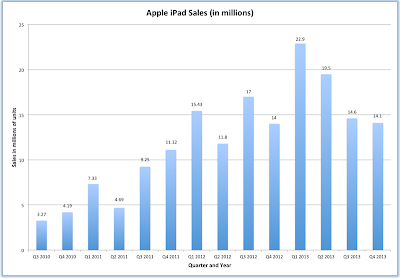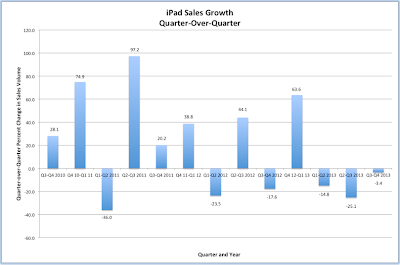Let me open with a disclaimer: I am an iPad owner. I use it everyday and yes, I am very happy with its performance. I used to travel for both pleasure and business with a laptop and have definitely found the iPad to be a breath of fresh air. While it doesn't do everything, it does enough to make me happy.
A lot of naysayers out are predicting the end of the Apple era or at the very least the end of the Apple growth era. While most analysts focus on the iPhone , I wanted to take a look at Apple's other flagship product; the iPad. Let's start by looking at the iPad United States unveiling dates by version so that you can match the release dates with the sales numbers:
iPad 1 – April 3, 2010
iPad 2 – March 2, 2011
iPad 3 – March 7, 2012
iPad 4 – October 23, 2012 – introduced iPad Mini
iPad 5 – October 22, 2013
Now, let's look at a graph that shows iPad sales by quarter since its introduction in the second quarter of 2010:
The climb in sales has been pretty steady, however, what is worrying is the decline over the second and third quarters of 2013 where sales dropped from 22.9 million in Q1 2013 to 14.6 million in Q3 2013, a total drop of 8.3 million units. With today's release, we find that sales dropped even further to 14.1 million units in Q4 2013 for a total drop of 8.8 million units on the year.
Here's a graph that shows the quarter-over-quarter sales volume gains and losses:
The best quarter-over-quarter gain was back in Q2 to Q3 2011 when sales rose by 97.2 percent, just after iPad 2 was introduced. Notice that from Q2 to Q3 2013, there has been a substantial cumulative drop in sales; with the release of fiscal 2013 data, there are now three quarters with quarter-over-quarter sales drops, the longest losing streak since the iPad was introduced three and a half years ago. Since unit sales peaked in the first quarter of 2013, volumes have dropped by 38.4 percent, a not insignificant amount and a trend that one would hope (if they were Apple) would be reversed soon.
Lastly, let's put the sales of iPads into corporate-wide perspective. In 2012, Apple's total net sales were $156,508 billion. Net sales of iPads was $32.424 billion or 20.7 percent of the total, the second largest net seller in Apple's relatively narrow slate of products. By way of comparison, iPhone sales were $80.477 billion or 41.5 percent of total net sales.
It will be interesting to watch the sales trends for Apple's tablet. With the product making up a substantial portion of Apple's overall net sales, a continuing drop in sales will definitely put a damper on earnings growth in the future, particularly if Apple does not have an innovative replacement product in its stable.
Click HERE to read more of Glen Asher's columns
You can publish this article on your website as long as you provide a link back to this page.



Be the first to comment